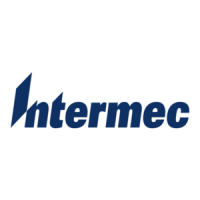TRAKKER Antares 2420 and 2425 Hand-Held Terminal User’s Manual
N
ugg
Co de 39
5-12
Using the DCS 300 to Download Applications
You can download applications and files to a T2425 using either the serial port or RF
communications. For help downloading via the serial port, see the previous section. The
advantage to downloading files via RF communications is that you can download
multiple files to one or more terminals.
You use RF communications to download applications from the DCS 300 to T2425s
running UDP Plus or from the host to T2425s running TCP/IP. This section explains
how to use the DCS 300 to download applications and files. For help downloading files
in a TCP/IP network, see Chapter 4, “Operating the Terminal in a Network.”
To download applications and files from the DCS 300
1. Copy the applications and files to the DCS 300.
2. Download the applications and files to the T2425.
Each step is described in the next sections. Before you start, make sure the T2425 is
communicating with the DCS 300. If you need any help installing or configuring the
network, see Chapter 4, “Operating the Terminal in a Network.”
Copying Files to the DCS 300
You can use these instructions to copy binary applications and files from a 3.5-inch disk
to the DCS 300.
To copy applications and files to the DCS 300
1. Insert the 3.5-inch disk that contains the files in the disk drive of the DCS 300.
2. From the main menu sidebar buttons, choose File Handling. The File Handling dialog
box appears.
3. In the File Handling list box, select Restore User Files and choose OK. A message
box appears telling you to insert the floppy disk in the disk drive of the DCS 300.
4. Choose OK. The Restore User Files dialog box appears. The files on the floppy disk
appear in the Available Files list box.

